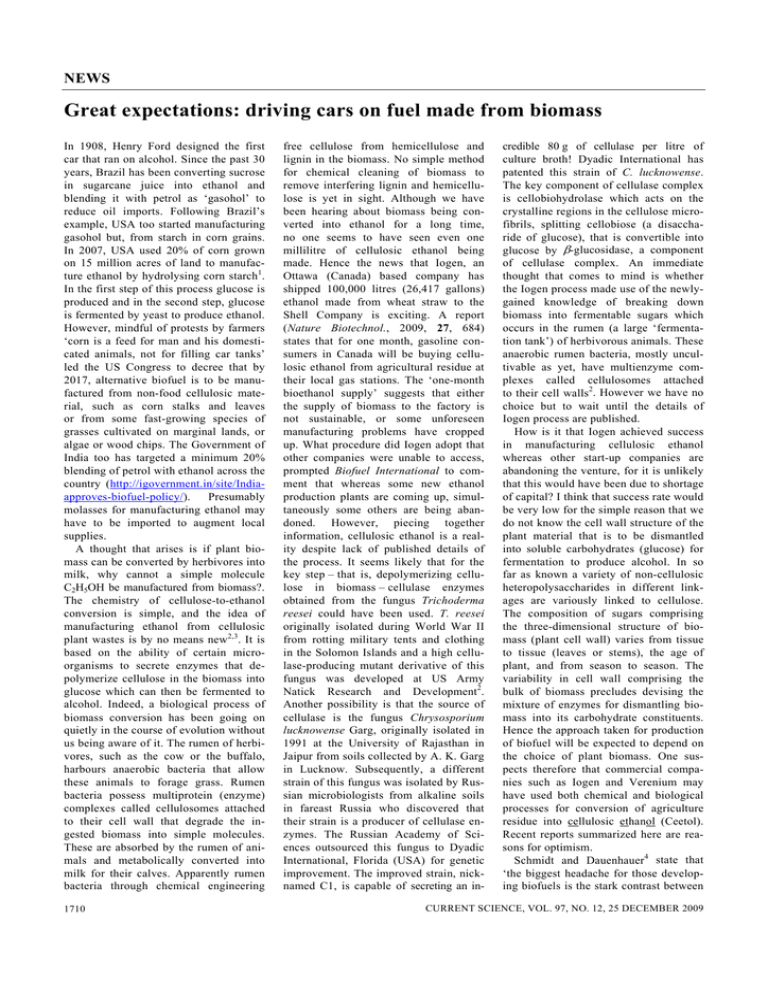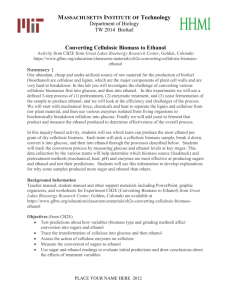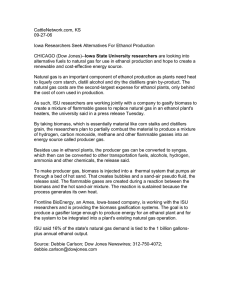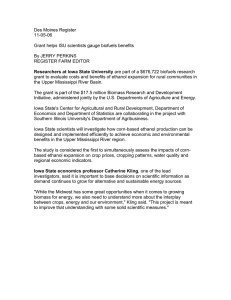Great expectations: driving cars on fuel made from biomass NEWS
advertisement

NEWS Great expectations: driving cars on fuel made from biomass In 1908, Henry Ford designed the first car that ran on alcohol. Since the past 30 years, Brazil has been converting sucrose in sugarcane juice into ethanol and blending it with petrol as ‘gasohol’ to reduce oil imports. Following Brazil’s example, USA too started manufacturing gasohol but, from starch in corn grains. In 2007, USA used 20% of corn grown on 15 million acres of land to manufacture ethanol by hydrolysing corn starch1. In the first step of this process glucose is produced and in the second step, glucose is fermented by yeast to produce ethanol. However, mindful of protests by farmers ‘corn is a feed for man and his domesticated animals, not for filling car tanks’ led the US Congress to decree that by 2017, alternative biofuel is to be manufactured from non-food cellulosic material, such as corn stalks and leaves or from some fast-growing species of grasses cultivated on marginal lands, or algae or wood chips. The Government of India too has targeted a minimum 20% blending of petrol with ethanol across the country (http://igovernment.in/site/Indiaapproves-biofuel-policy/). Presumably molasses for manufacturing ethanol may have to be imported to augment local supplies. A thought that arises is if plant biomass can be converted by herbivores into milk, why cannot a simple molecule C2H5OH be manufactured from biomass?. The chemistry of cellulose-to-ethanol conversion is simple, and the idea of manufacturing ethanol from cellulosic plant wastes is by no means new2,3. It is based on the ability of certain microorganisms to secrete enzymes that depolymerize cellulose in the biomass into glucose which can then be fermented to alcohol. Indeed, a biological process of biomass conversion has been going on quietly in the course of evolution without us being aware of it. The rumen of herbivores, such as the cow or the buffalo, harbours anaerobic bacteria that allow these animals to forage grass. Rumen bacteria possess multiprotein (enzyme) complexes called cellulosomes attached to their cell wall that degrade the ingested biomass into simple molecules. These are absorbed by the rumen of animals and metabolically converted into milk for their calves. Apparently rumen bacteria through chemical engineering 1710 free cellulose from hemicellulose and lignin in the biomass. No simple method for chemical cleaning of biomass to remove interfering lignin and hemicellulose is yet in sight. Although we have been hearing about biomass being converted into ethanol for a long time, no one seems to have seen even one millilitre of cellulosic ethanol being made. Hence the news that Iogen, an Ottawa (Canada) based company has shipped 100,000 litres (26,417 gallons) ethanol made from wheat straw to the Shell Company is exciting. A report (Nature Biotechnol., 2009, 27, 684) states that for one month, gasoline consumers in Canada will be buying cellulosic ethanol from agricultural residue at their local gas stations. The ‘one-month bioethanol supply’ suggests that either the supply of biomass to the factory is not sustainable, or some unforeseen manufacturing problems have cropped up. What procedure did Iogen adopt that other companies were unable to access, prompted Biofuel International to comment that whereas some new ethanol production plants are coming up, simultaneously some others are being abandoned. However, piecing together information, cellulosic ethanol is a reality despite lack of published details of the process. It seems likely that for the key step – that is, depolymerizing cellulose in biomass – cellulase enzymes obtained from the fungus Trichoderma reesei could have been used. T. reesei originally isolated during World War II from rotting military tents and clothing in the Solomon Islands and a high cellulase-producing mutant derivative of this fungus was developed at US Army Natick Research and Development2. Another possibility is that the source of cellulase is the fungus Chrysosporium lucknowense Garg, originally isolated in 1991 at the University of Rajasthan in Jaipur from soils collected by A. K. Garg in Lucknow. Subsequently, a different strain of this fungus was isolated by Russian microbiologists from alkaline soils in fareast Russia who discovered that their strain is a producer of cellulase enzymes. The Russian Academy of Sciences outsourced this fungus to Dyadic International, Florida (USA) for genetic improvement. The improved strain, nicknamed C1, is capable of secreting an in- credible 80 g of cellulase per litre of culture broth! Dyadic International has patented this strain of C. lucknowense. The key component of cellulase complex is cellobiohydrolase which acts on the crystalline regions in the cellulose microfibrils, splitting cellobiose (a disaccharide of glucose), that is convertible into glucose by β-glucosidase, a component of cellulase complex. An immediate thought that comes to mind is whether the Iogen process made use of the newlygained knowledge of breaking down biomass into fermentable sugars which occurs in the rumen (a large ‘fermentation tank’) of herbivorous animals. These anaerobic rumen bacteria, mostly uncultivable as yet, have multienzyme complexes called cellulosomes attached to their cell walls2. However we have no choice but to wait until the details of Iogen process are published. How is it that Iogen achieved success in manufacturing cellulosic ethanol whereas other start-up companies are abandoning the venture, for it is unlikely that this would have been due to shortage of capital? I think that success rate would be very low for the simple reason that we do not know the cell wall structure of the plant material that is to be dismantled into soluble carbohydrates (glucose) for fermentation to produce alcohol. In so far as known a variety of non-cellulosic heteropolysaccharides in different linkages are variously linked to cellulose. The composition of sugars comprising the three-dimensional structure of biomass (plant cell wall) varies from tissue to tissue (leaves or stems), the age of plant, and from season to season. The variability in cell wall comprising the bulk of biomass precludes devising the mixture of enzymes for dismantling biomass into its carbohydrate constituents. Hence the approach taken for production of biofuel will be expected to depend on the choice of plant biomass. One suspects therefore that commercial companies such as Iogen and Verenium may have used both chemical and biological processes for conversion of agriculture residue into cellulosic ethanol (Ceetol). Recent reports summarized here are reasons for optimism. Schmidt and Dauenhauer4 state that ‘the biggest headache for those developing biofuels is the stark contrast between CURRENT SCIENCE, VOL. 97, NO. 12, 25 DECEMBER 2009 NEWS what we have (biomass rich in carbohydrates) and what we want (oxygendeficient fuels)’. Carbohydrates, such as cellulose and starch, comprise as much as 75% of biomass sources – typically, corn (maize) stover, wheat straw, wood chips. Cellulose is a bundle of chains; each chain is assembled from thousands of glucose units; each unit is six-carbon atoms and a similar number of oxygen atoms. However, optimal fuel molecules must be small (only 5–15 carbons) containing little oxygen. The challenge of producing biofuels is in finding a way to breakdown long carbohydrate chains to small, usable molecules, while simultaneously removing the oxygen and minimizing the loss of energy value of the original biomass. Most of us think of ethanol as the alternate fuel and to a lesser extent biodiesel. In a breakthrough development towards achieving the goal of biofuel, James A. Dumesic’s group at the University of Wisconsin-Madison has developed a catalytic strategy for transforming biomass resources into 2,5-dimethylfuran as an alternative liquid fuel5. Although large-scale tests do not appear to have been carried out as yet, this is a new chemical catalytic strategy based on the production of dimethylfuran from fructose (a carbohydrate obtained directly from biomass or by the isomerization of glucose) for possible use as a liquid transportation fuel. Compared to ethanol, 2,5-dimethylfuran has a higher energy density (40%), a higher boiling point (20 K), and is not soluble in water. Binder and Raines6 reported that hydroxymethylfuran from lignocellulose is obtained with up to 48% yield. Another alternative biofuel could be butanol, a 4-carbon alcohol which more closely resembles the hydrocarbons in gasoline (usually 4–12 carbon atoms). Besides its higher energy density and suitability for use in unmodified internal combustion engines, butanol is also less corrosive and less water soluble than ethanol. The associated convenience for storage and transportation favour easier integration of butanol into the existing transportation infrastructure. Atsumi et al.7 report a metabolic engineering approach, coaxing Escherichia coli into producing higher alcohols including isobutanol, 1-butanol, 2-methyl-1-butanol, 3-methyl-1-butanol and 2-phenyl ethanol from glucose. This strategy diverts 2keto acid intermediates in its amino acid biosynthetic pathway for alcohol synthesis (Figure 1). They report that the strategy can be applied to yeast, stating ‘In particular, we have achieved high-yield, high-specificity production of isobutanol from glucose’. Imagine yeast – hitherto being grown in huge tanks (fermentation vessels) for producing beer or wine being used in future for making fuel for cars! Whatever, the lesson is: do not underestimate the power of microorganisms. The complexity of making fuel from biomass is similar to the Apollo or the Chandrayaan missions. It is unlikely to be achieved without appropriate investment in plant and microbial sciences and chemical engineering. One might argue that the cost and economics of making biofuel are prohibitive, or that there is just not enough land to grow biomass, or that biofuels would lead to indiscriminate cutting of plants and trees leading to deforestation, or carbon emission. The hard truth is that in an energy-starved world due to depleting fossil fuels and rising population, fuel – whatever its chemical nature and however it is made – would still be in demand. Let us not throw the baby out of the tub with the bath water. 1. Pimentel, D. et al., Hum. Ecol., 2009, 37, 1–12. 2. Maheshwari, R., Curr. Sci., 2008, 95, 594– 602. 3. Maheshwari, R., Curr. Sci., 2009, 96, 455– 456. 4. Schmidt, L. D. and Dauenhauer, P. J., Nat. Rep. Clim. Change, 2007, 3, 44–46. 5. Huber, G. W., Chheda, J. N., Barrett, C. J. and Dumesic, J. A., Science, 2005, 308, 1446–1450. 6. Binder, J. B. and Raines, R. T., J. Am. Chem. Soc., 2009, 131, 1979–1985. 7. Atsumi, S., Hanai, T. and Liao, C., Nature, 2008, 451, 86–90. 8. Keasling, J. D. and Chou, H., Nat. Biotechnol., 2008, 26, 298–299. Figure 1. Diverting key intermediates in E. coli to generate fuels. Fuels generated by 7 Atsumi et al. by diversion of keto-acid intermediates in amino acid biosynthetic pathways. Source: Ref. 8. CURRENT SCIENCE, VOL. 97, NO. 12, 25 DECEMBER 2009 Ramesh Maheshwari (formerly at Department of Biochemistry, Indian Institute of Science, Bangalore) lives at 53/13, Sriteertha Apartments, 4th Main, 17th Cross, Malleswaram, Bangalore 560 003, India. e-mail: ramesh.maheshwari01@gmail.com 1711




